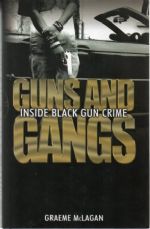GUNS AND GANGS Inside Black Gun Crime
Author: McLagan (Graeme)
Year: 2005
Publisher: Allison & Busby
Edition Details: 1st Edn.
Book Condition: F/NrF
ISBN: 9780749083489
Price: £12.00
IN STOCK NOW
Hardback. The author lifts the lid on, at the time, a hugely unreported but important modern-day problem - an expensive problem both in terms of money and young lives, After terrorism, the single greatest worry for law enforcement agencies was gun crime, and in particular the so-called 'black on black' shootings. The statistics were shocking. Black people were the victims of three-quarters of the capital's gun murders and non-fatal shootings. The shooters in 80% of cases were also black. Most black gun crime occurs in London, but Bristol, Manchester and the West Midlands are also affected; gun crime has become a national concern. The author traces how the trend first started in the late 1980s and early 1990s with the emergence of the so-called Yardies and crack cocaine, and the consequent turf wars. Since then the Police have launched numerous operations to tackle the problem, the big turning point for which came after the murder of black teenager Stephen Lawrence. Most of these operations were kept secret over the years. Scotland Yard was prepared to open up Operation Trident in an unprecedented way, allowing the author exclusive access to files and case histories, showing how black gun crime was being confronted in a joint effort by police and the black community. In 2004 there were the first welcome signs of black gun crime decreasing, but the easy availability of guns and community violence in other areas of society means that this problem is far from solved. This in-depth study, containing interviews with police officers, victims, their families, witnesses, lawyers and perpetrators, highlights this under-explored phenomena and offers valuable insights into the psychology behind this disturbing form of crime. Illus. + Index. 253pp. 8vo. h/back. F. in Nr. F. dw.
Titles Recently Added To The Catalogue
Wants list
If you're after a particular title, enter your details below
Selling a Book?
Enter the details below and we'll be in touch shortly


